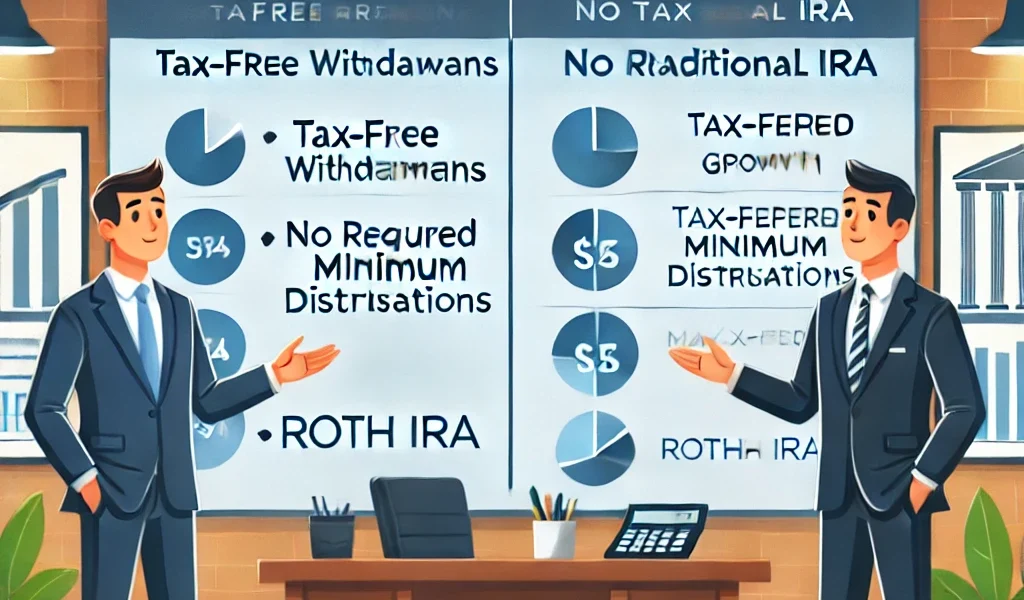Introduction
When planning for retirement, choosing the right savings vehicle is essential to ensure financial security. Individual Retirement Accounts (IRAs) are among the most popular options, offering significant tax advantages and long-term growth potential. Two primary types of IRAs are the Roth IRA and the Traditional IRA.
Both accounts provide unique benefits, but selecting the right one depends on your financial situation, income level, tax strategy, and retirement goals. In this article, we’ll break down the key differences between Roth IRA vs. Traditional IRA to help you make an informed decision.
What is a Traditional IRA?
A Traditional IRA is a tax-deferred retirement savings account that allows individuals to contribute pre-tax dollars. This means you get an immediate tax benefit by deducting contributions from your taxable income, which can lower your current tax bill. However, when you withdraw funds in retirement, they are taxed as ordinary income.
Key Features of a Traditional IRA:
- Tax Deductible Contributions: Contributions reduce your taxable income for the year (subject to eligibility based on income and employer plan participation).
- Tax-Deferred Growth: Investment gains are not taxed until withdrawals begin in retirement.
- Mandatory Distributions: Required Minimum Distributions (RMDs) must begin at age 73.
- Penalties for Early Withdrawals: Withdrawals before age 59½ may incur a 10% penalty, plus income tax.
What is a Roth IRA?
A Roth IRA is a retirement savings account that allows individuals to contribute after-tax income. While contributions are not tax-deductible, withdrawals (including earnings) are tax-free in retirement, provided certain conditions are met.
Key Features of a Roth IRA:
- Tax-Free Withdrawals: Qualified withdrawals in retirement are tax-free.
- No Required Minimum Distributions (RMDs): Unlike Traditional IRAs, you are not forced to withdraw money at a certain age.
- Flexible Withdrawal Rules: Contributions (but not earnings) can be withdrawn at any time without penalties.
- Income Limitations: Higher earners may be restricted from direct contributions.
Key Differences Between Roth IRA and Traditional IRA
| Feature | Roth IRA | Traditional IRA |
|---|---|---|
| Tax Treatment on Contributions | After-Tax (No immediate deduction) | Pre-Tax (Contributions may be deductible) |
| Tax Treatment on Withdrawals | Tax-Free (Qualified withdrawals) | Taxed as ordinary income |
| Income Limits for Contributions | Yes (Income phase-out applies) | No income limits for contributions, but deduction limits apply |
| Required Minimum Distributions (RMDs) | No RMDs | RMDs start at age 73 |
| Early Withdrawal Rules | Contributions can be withdrawn anytime tax-free; earnings subject to penalty before 59½ (unless qualified) | Withdrawals before 59½ subject to 10% penalty and income tax (some exceptions apply) |
| Best For | Those expecting to be in a higher tax bracket in retirement | Those expecting to be in a lower tax bracket in retirement |
Which IRA is Best for You?
The best choice between a Roth IRA and a Traditional IRA depends on multiple factors, including your current and future tax situation, income level, and retirement goals. Here’s how to decide:
Choose a Roth IRA If:
✔️ You expect your income (and tax rate) to be higher in retirement. ✔️ You want tax-free withdrawals during retirement. ✔️ You want no required minimum distributions (RMDs). ✔️ You want the flexibility to withdraw contributions anytime. ✔️ You fall within the income limits for Roth contributions.
Choose a Traditional IRA If:
✔️ You expect your income (and tax rate) to be lower in retirement. ✔️ You want an immediate tax deduction to lower your current taxable income. ✔️ You don’t mind paying taxes on withdrawals in retirement. ✔️ You want to maximize tax-deferred growth on your investments. ✔️ You are not eligible to contribute to a Roth IRA due to income limits.
Contribution Limits for 2024
Both Roth and Traditional IRAs have the same annual contribution limits set by the IRS:
- Individuals Under 50: $7,000 per year
- Individuals 50 and Older: $8,000 per year (includes $1,000 catch-up contribution)
Income Limits for Roth IRA Contributions (2024)
The ability to contribute to a Roth IRA depends on your Modified Adjusted Gross Income (MAGI):
| Filing Status | Full Contribution (MAGI) | Partial Contribution (MAGI) | No Contribution (MAGI) |
| Single | Up to $146,000 | $146,000 – $161,000 | Above $161,000 |
| Married Filing Jointly | Up to $230,000 | $230,000 – $240,000 | Above $240,000 |
If your income is above these limits, you can still contribute via a Backdoor Roth IRA strategy by converting a Traditional IRA into a Roth IRA.
Withdrawal Rules and Penalties
Traditional IRA:
- Withdrawals before age 59½ incur a 10% penalty plus income tax.
- Required Minimum Distributions (RMDs) begin at age 73.
Roth IRA:
- Contributions can be withdrawn anytime without penalty.
- Earnings can be withdrawn tax-free after age 59½, provided the account is at least 5 years old.
- No RMDs, allowing your savings to grow longer.
Tax Implications: When Do You Pay Taxes?
- With a Traditional IRA, you get tax benefits now but pay taxes later.
- With a Roth IRA, you pay taxes now but enjoy tax-free income later.
Conclusion: Making the Right Choice
Choosing between a Roth IRA and a Traditional IRA depends on your current and future financial situation. If you believe you’ll be in a higher tax bracket in retirement, a Roth IRA may be the better choice. However, if you expect a lower tax rate in retirement, a Traditional IRA can offer immediate tax savings.
Key Takeaways:
✅ Roth IRA offers tax-free withdrawals in retirement, making it ideal for future higher earners. ✅ Traditional IRA provides tax deductions today, beneficial for those who need immediate tax relief. ✅ Consider your current vs. future tax bracket to make the best choice. ✅ Both accounts have the same contribution limits but different tax structures. ✅ Roth IRAs have income restrictions, while Traditional IRAs have deduction limits.
Final Thought:
For many individuals, a combination of both Roth and Traditional IRAs may provide a balanced retirement strategy. Consulting a financial advisor can help tailor the best approach for your unique situation.




